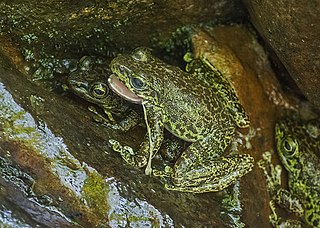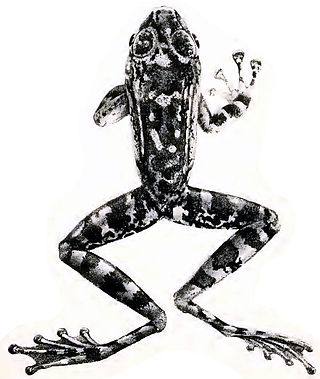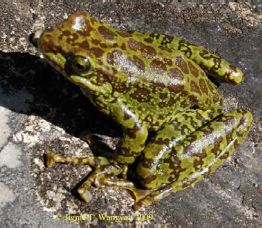
Amolops formosus, also known as Assam sucker frog, beautiful stream frog, Assam cascade frog, or hill stream frog, is a species of frog found in high gradient streams of northern India, northern Bangladesh, and Nepal, possibly also Bhutan, although these records may represent confusion between Amolops himalayanus and this species; the latest available IUCN assessment from 2004 treats A. himalayanus as a synonym of A. formosus.

Amolops marmoratus is a species of ranid frog found in Asia. Its common names include marbled sucker frog, marbled cascade frog, Pegu torrent frog, and many others. The taxonomic status of many populations formerly assigned to this species is uncertain.
Amolops monticola is a species of frog in the family Ranidae, the "true frogs". It is found in the Northeast India, eastern Nepal, and western China, although there is some uncertainty regarding the Chinese records. It probably also occurs in the intervening Bhutan. Common names mountain sucker frog, mountain stream frog, mountain torrent frog, and mountain cascade frog have been coined for it.
Amolops viridimaculatus, also known as green-spotted torrent frog, Dahaoping sucker frog, and Dahaoping cascade frog, is a species of frog found in Yunnan, China, northern Vietnam, northern Myanmar, and Nagaland, Northeast India; it is also expected to occur in northern Laos.

Boulenophrys brachykolos, the short-legged horned toad or Peak spadefoot toad, is a frog native to southern China and Vietnam. It was first discovered in the Victoria Peak, Hong Kong. Many populations of Hong Kong are in the country parks, such as Lung Fu Shan Country Park.

Amolops cremnobatus is a species of frogs in the family Ranidae. It is found in north-central Laos and Vietnam. Its range might extend into Thailand. The specific name cremnobatus is derived from Greek kremnobates, meaning "frequenter of steep places", and refers to the steep waterfall from which the type series were collected. Common name Lao sucker frog has been coined for it.

Amolops larutensis is a species of frog in the family Ranidae that is found in the Malay Peninsula from southernmost Thailand to Malaysia; records further north probably represent A. panhai.
Amolops loloensis is a species of frog in the family Ranidae that is found in southern and western Sichuan and one locality in north-central Yunnan, China. Its natural habitats are small mountain streams in forests and grasslands. It is threatened by infrastructure development for human settlement, potentially also by water pollution from the mining industry. T

Amolops mantzorum, commonly known as the Sichuan torrent frog or Kangting sucker frog, is a species of frog in the family Ranidae. It is found in Gansu, Sichuan, and Yunnan Provinces of China. It has recently been reported also from Bhutan.
Amolops nepalicus is a species of frog in the family Ranidae. It is endemic to Nepal and is only known from two localities in the Sankhuwasabha District. Common names Nepal sucker frog and Nepal cascade frog have been proposed for it.

Amolops ricketti is a species of frog in the family Ranidae that is found in southern and eastern China and northern and central montane Vietnam.

Amolops spinapectoralis is a species of frog in the family Ranidae, the "true frogs". It is at present only known from a few locations in central Vietnam—that is, it is endemic to Vietnam—but it is likely to be found more widely in the Vietnamese Central Highlands as well as in the adjacent southeastern Laos and northeastern Cambodia. The specific name spinapectoralis is derived from Latin spina for "thorn" and pectoralis for "of the breast" and refers to the pectoral spines in adult males. Common name spinyback torrent frog has been coined for it.

Amolops torrentis, commonly known as the torrent sucker frog or the little torrent frog is a species of frog in the family Ranidae and genus Amolops that is endemic to China, specifically only on the island of Hainan. They are most likely to be found in streams and surrounding wetland areas. Males have high-pitched mating calls, which are favored by females. Glands on this species' skin can secrete toxins. This species suffers from parasitism and habitat loss. Currently it is listed as vulnerable by the IUCN and is protected by law in China.
Amolops tuberodepressus is a species of frog in the family Ranidae. It is endemic to Yunnan, China and known from Wuliang and Ailao Mountains in Jingdong County. Once suspected to be synonym of Amolops mantzorum, its validity was confirmed with molecular methods in 2014.
Amolops mengyangensis is a species of frog in the family Ranidae. It is known with certainty only from its type locality, the eponymous Mengyang in Xishuangbanna Dai Autonomous Prefecture, southern Yunnan province of China. However, if Amolops daorum is its junior synonym, distribution of Amolops mengyangensis would be considerably wider, including the vicinity of Sa Pa in northern Vietnam near the Chinese border, Hong Kong, and Houaphanh Province in eastern Laos, and presumably also including the intervening areas.
Meristogenys phaeomerus is a species of frog in the family Ranidae. It is endemic to Borneo and known from central Sarawak (Malaysia) and adjacent Kalimantan (Indonesia). The specific name phaeomerus is derived from the Greek phaios for "dusky" and meros for "thigh", in reference to the appearance of the rear of the thigh. Common names Kapit Borneo frog and Kapit torrent frog have been coined for it.

Quasipaa exilispinosa is a species of frog in the family Dicroglossidae. It is known under many common names, including Hong Kong spiny frog, common spiny frog, lesser spiny frog, little spiny frog, and Hong Kong paa frog. It has a patchy distribution in southern China including Hong Kong. Its natural habitats are subtropical hill streams in forests or shrublands, and sometimes also seepages, stream-fed marshes, and forests. It is threatened by over-collecting for human consumption and by habitat loss.

Quasipaa spinosa is a species of frog in the family Dicroglossidae. It is known under many common names, including Chinese spiny frog, giant spiny frog, Chinese edible frog, and spiny paa frog. Its names refer to the distinctive characteristics of the species, relatively large size and the spiny chest of male frogs. Giant in frog terms only, it can nevertheless grow to lengths above 10 cm (4 in); this makes it the largest frog in Hong Kong.
Amolops daorum is a species of frog in the family Ranidae. It is known from its type locality in the vicinity of Sa Pa in northern Vietnam near the Chinese border, Hong Kong, and Houaphanh Province in eastern Laos; presumably it also occurs the intervening areas. The Hong Kong record is considered suspicious, however.















